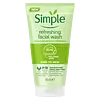Simple Skincare Kind to Skin Vital Vitamin Day Cream SPF 15 Versus Simple Skincare Kind To Skin Refreshing Facial Wash
What's inside
What's inside
 Key Ingredients
Key Ingredients

 Benefits
Benefits

 Concerns
Concerns

 Ingredients Side-by-side
Ingredients Side-by-side

Water
Skin ConditioningEthylhexyl Methoxycinnamate
UV AbsorberDicaprylyl Carbonate
EmollientGlycerin
HumectantHydrogenated Polydecene
EmollientCetearyl Alcohol
EmollientButyl Methoxydibenzoylmethane
UV AbsorberDimethicone
EmollientCaprylic/Capric Triglyceride
MaskingButylene Glycol
HumectantBisabolol
MaskingBHT
AntioxidantCaprylyl Glycol
EmollientCetyl Alcohol
EmollientHydrogenated Polyisobutene
EmollientNiacinamide
SmoothingPhenoxyethanol
PreservativePrunus Amygdalus Dulcis Oil
Skin ConditioningSodium Polyacrylate
AbsorbentSodium Stearoyl Glutamate
CleansingStearyl Caprylate
EmollientStearyl Heptanoate
EmollientSucrose Polystearate
EmollientTocopherol
AntioxidantTocopheryl Acetate
AntioxidantZingiber Officinale Root Extract
MaskingWater, Ethylhexyl Methoxycinnamate, Dicaprylyl Carbonate, Glycerin, Hydrogenated Polydecene, Cetearyl Alcohol, Butyl Methoxydibenzoylmethane, Dimethicone, Caprylic/Capric Triglyceride, Butylene Glycol, Bisabolol, BHT, Caprylyl Glycol, Cetyl Alcohol, Hydrogenated Polyisobutene, Niacinamide, Phenoxyethanol, Prunus Amygdalus Dulcis Oil, Sodium Polyacrylate, Sodium Stearoyl Glutamate, Stearyl Caprylate, Stearyl Heptanoate, Sucrose Polystearate, Tocopherol, Tocopheryl Acetate, Zingiber Officinale Root Extract
 Reviews
Reviews

Ingredients Explained
These ingredients are found in both products.
Ingredients higher up in an ingredient list are typically present in a larger amount.
Glycerin is already naturally found in your skin. It helps moisturize and protect your skin.
A study from 2016 found glycerin to be more effective as a humectant than AHAs and hyaluronic acid.
As a humectant, it helps the skin stay hydrated by pulling moisture to your skin. The low molecular weight of glycerin allows it to pull moisture into the deeper layers of your skin.
Hydrated skin improves your skin barrier; Your skin barrier helps protect against irritants and bacteria.
Glycerin has also been found to have antimicrobial and antiviral properties. Due to these properties, glycerin is often used in wound and burn treatments.
In cosmetics, glycerin is usually derived from plants such as soybean or palm. However, it can also be sourced from animals, such as tallow or animal fat.
This ingredient is organic, colorless, odorless, and non-toxic.
Glycerin is the name for this ingredient in American English. British English uses Glycerol/Glycerine.
Learn more about GlycerinPhenoxyethanol is a preservative that has germicide, antimicrobial, and aromatic properties. Studies show that phenoxyethanol can prevent microbial growth. By itself, it has a scent that is similar to that of a rose.
It's often used in formulations along with Caprylyl Glycol to preserve the shelf life of products.
Tocopheryl Acetate is AKA Vitamin E. It is an antioxidant and protects your skin from free radicals. Free radicals damage the skin by breaking down collagen.
One study found using Tocopheryl Acetate with Vitamin C decreased the number of sunburned cells.
Tocopheryl Acetate is commonly found in both skincare and dietary supplements.
Learn more about Tocopheryl AcetateWater. It's the most common cosmetic ingredient of all. You'll usually see it at the top of ingredient lists, meaning that it makes up the largest part of the product.
So why is it so popular? Water most often acts as a solvent - this means that it helps dissolve other ingredients into the formulation.
You'll also recognize water as that liquid we all need to stay alive. If you see this, drink a glass of water. Stay hydrated!
Learn more about Water